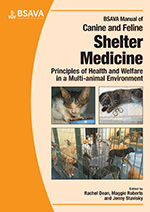
Full text loading...

Shelter medicine is a newly emerging discipline of veterinary medicine, which involves working closely with charitable organizations. This chapter covers: clinical approach to herd health in companion animals, the decision-making process, challenges of shelter medicine, principles and skills needed to meet the challenges. Quick reference guide: Top 10 tips for shelter medicine vets.
What is shelter medicine?, Page 1 of 1
< Previous page | Next page > /docserver/preview/fulltext/10.22233/9781910443330/9781910443330.1-1.gif

Full text loading...













